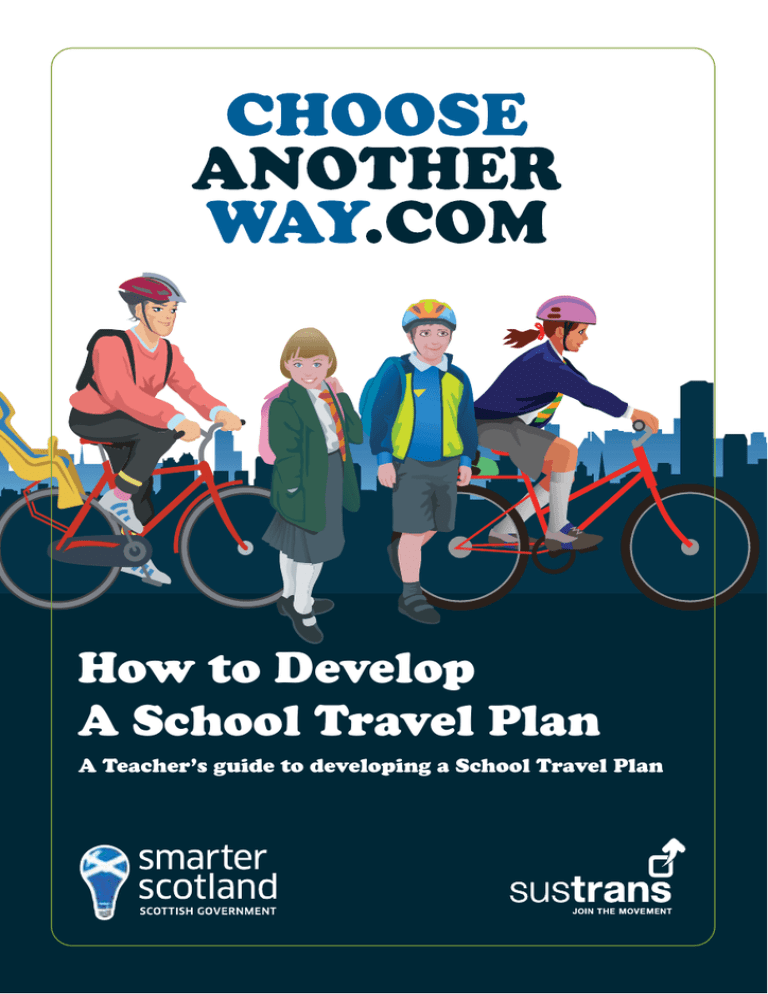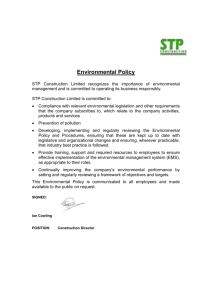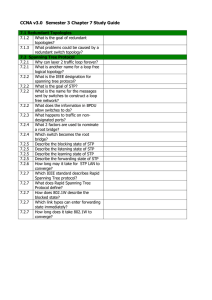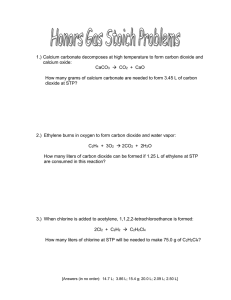How to Develop A School Travel Plan
advertisement

How to Develop A School Travel Plan A Teacher’s guide to developing a School Travel Plan Contents Introduction 3 What is a School Travel Plan? 4 What is the aim of a School Travel Plan? 5 What are the benefits of a School Travel Plan? 6 Who might be involved in developing your plan? 7 Ideas… 8 And overall aims… 9 Step 1: Getting Started 10 Step 2: Key Information – consultation and surveys 11 Step 2: Key Information – analysis and results 12 Step 3: Action plan 13 Step 4: Monitoring and review – celebrate or reassess 14 Step 4: Monitoring and review – update and maintain 15 Guide to Success 16 Want to find out more? 17 Introduction This leaflet has been developed by School Travel Co-ordinators on behalf of the Scottish Government to help and support you and your school in the development of a School Travel Plan. It offers practical guidance and suggestions on how to develop a School Travel Plan, linking it successfully to the Curriculum for Excellence and other programmes being undertaken in schools. Developing a School Travel Plan is relevant to all types and sizes of school whether in an urban or rural setting. As you will be aware, there is growing concern surrounding the issues of congestion and its impact on our environment and air quality, the health and inactivity of our children and the long term health and financial implications a sedentary lifestyle may have on our country. Through working together to raise the awareness of the positive benefits of more active and sustainable travel choices, such as walking, cycling or using public transport, we can bring about attitude and behaviour changes and encourage positive lifestyle choices amongst pupils, parents and school staff. 3 What is a School Travel Plan? Over the last decade fewer children have been walking or cycling to school. More and more travel by car, thus limiting their opportunities to develop good travel habits that benefit their health, well-being and independence. A School Travel Plan (STP) is a simple written document that identifies local issues relating to the school journey, sets out a strategy of agreed aims and identifies a package of measures designed to promote more sustainable travel choices for pupils, parents, staff and visitors to your school. Sustainable travel choices may include walking, cycling, public transport and lift sharing. A STP document can be embedded into many parts of the curriculum throughout early years, primary and secondary school programmes and follows ideals set out in the Curriculum for Excellence. 4 Through consultationbased activities with all interested parties, a STP can develop individual measurable aims and objectives, clearly stated targets and initiatives to encourage healthier longterm sustainable travel choices. A STP should be linked to the school development plan. It is a working document that needs to be monitored and reviewed regularly. Writing a travel plan is not something that can be done overnight. For a plan to be effective, a framework should be put in place to encourage sustainable travel patterns. What is the aim of a School Travel Plan? An effective School Travel Plan (STP) has the following aims... ...to reduce the volume of vehicles on the school run Health Obesity levels in the UK are increasing at over twice the rate of most other European Countries, 1:5 boys and 1:4 girls are now classed as overweight or obese1. to improve safety on the school journey to pro-actively encourage healthy and environmentally friendly travel choices. It also helps pupils gain a better understanding of the health, environmental and social benefits of more walking, cycling and the use of public transport as an alternative to unnecessary car usage. This will encourage the formation of active travel habits that can be carried through into adult life. A school can use its STP to demonstrate a clear and real commitment to the promotion of health, environmental and community issues. It will help support and define school policies in relation to travel which can then be embedded in the ethos and ongoing development/improvement plans of the school. 1 Scottish Health survey 2003. 5 What are the benefits of a School Travel Plan? • Contributes towards Curriculum for Excellence, Health Promoting Schools, Eco Schools, and the Active Schools programme • Provides a framework for curriculum links eg citizenship, Personal and Social Development (PSD), health education, environmental studies, art, geography etc • Improves health and fitness through increased active travel • Improves travel awareness,road safety and user skills • Increases opportunity for independence and self-confidence • Improves alertness of pupils • Reduces traffic congestion around the school gate • Improves relationships with the school’s neighbours and local community • Improves the local environment by reducing noise pollution and vehicle exhaust emissions • Can help to secure funding for initiatives that promote active travel such as improved routes, cycle parking, improved infrastructure, publicity campaigns, and school-led projects • Reduces stress and time spent in traffic jams • Increases quality parent-child contact on the journey to school 6 Who might be involved in developing your plan? In order to develop and promote the school’s travel plan a ‘team’ will be needed. This should be led by someone with real enthusiasm and a willingness to champion active travel. If at all possible, the team should try to meet frequently whilst developing Steps 1, 2 and 3. The team will be made up of a variety of people and could have the following core members playing a part: Core members School Staff member in charge – they may be part of the Senior Management Team (SMT) or have a remit for Eco, Citizenship, Personal, Social and Health Education (PSHE), or other associated topics. Ideally, the staff members should have delegated authority. Pupils – invite interested Traffic Over the past 20 years the number of pupils being driven to school has doubled. At 8:50am almost 1:5 of the cars on the road in urban areas is going to school2. pupils to participate or utilise established groups such as Pupil Council, Eco Committee, Health Groups, Enterprise Group, Junior Road Safety Officers (JRSOs) etc. Parents – There may be parents with a particular interest or knowledge about travel issues who would like to be involved. Why not ask a parent who currently cycles to school? Local Authority School Travel Co-ordinator – can provide you with advice and help the team coordinate their efforts and liaise with other relevant agencies and departments. Co-opted members As your plan develops you may want to include other members for specific actions/campaigns. The list is not exhaustive but hopefully will give you an idea of the variety of people, depending on your school’s needs, who may be able to provide support: Local Media, Businesses, Councillors, Cycle Clubs and Shops, Community Groups, School/Public Transport Providers, School Crossing Patrollers, Police, Road Safety Officers, Active School Co-ordinator, Road Engineers, etc… 2 Department of Transport and Department for Education and Skills, Travelling to School: an action plan Sept 2003. 7 Ideas… Here are some ideas that will help support your School Travel Plan work, raising awareness and linking it to curriculum activities. school travel plan media launch have a STP travel plan notice board include active travel in primary to secondary transition programmes teach personal safety skills promote ‘park and stride’ Ideas lift sharing start a bicycle user group (BUG) develop a bus behaviour code walk to school initiatives introduce pedestrian skills training mapping analysis and activities absence notification schemes junior road safety officers 8 …and overall aims Your travel plan should tie in to your school's overall aspirations. It doesn’t matter what type of school yours is – Nursery, Primary, Secondary or SEN – a STP is relevant, covering a breadth of topics. Developed properly, a STP will support the school’s ethos and commitment to health, environmental awareness, safety issues and the social development of pupils. Link the STP to your development / quality improvement / health plan to ensure long-term sustainability. Road safety The number of child road traffic casualties in Scotland is decreasing. However, child car passengers continue to have the highest number of fatalities3. 3 Scottish Government Statistical Bulletin 2007. 9 Step 1: Getting started Set up your School Travel Team Think about who you want to have involved. Make the team as varied as possible and include pupils of differing ages. Are there other professionals, community personnel, volunteers who can help? Name your Team Choose a suitable name. It’s good for this special group to have a proper name that links with the group’s purpose. Where the School Travel Plan fits in The School Travel Plan supports the Curriculum for Excellence, Health Promoting Schools, Eco Schools and forms links over a host of different subjects including literacy, numeracy, environmental science, art, drama and citizenship. Successful learning It is real learning that incorporates experiences and outcomes. 10 Step 2: Key information – consultation and surveys Conducting a survey is a good starting point towards developing your STP. What type of survey could you use? 1. Hands Up Survey Is short, simple and particularly useful for young people. A teacher or senior pupil usually asks the survey questions of the whole class. 2. Pupils/Parents/Staff Survey These surveys are intended to collect information from individuals and will give a more in-depth analysis of the current travel habits, preferred travel choices, possible issues or concerns relating to the school journey from different perspectives. 3. Online Surveys Social inclusion The school journey provides an ideal opportunity for children to interact with peers, parents and other adults helping to build self-confidence independence and enhance social skills. There are a variety of useful Internet-based surveys that may be useful particularly for older pupils eg: Survey Monkey www.surveymonkey.com and Young Transnet www.youngtransnet.com. It is important to use a method you believe will produce the most meaningful and highest response rates, which can then be used to develop your plan. Collation The School Travel Team can collate the information gathered from the surveys, or alternatively the collation can be a class exercise supporting the development of literacy, number and Information Communication and Technology (ICT) skills. 11 Step 2: Key Information – analysis and results SMART Targets Targets help you evaluate success. They should be – Specific. Measurable. Achievable. Relevant. Timed. The information gathered from the surveys will help your School Travel Team decide the key objectives of your plan. This will focus the setting of your targets allowing you to monitor any change and take appropriate action at the review stage. Schools may be working on a STP for a number of different reasons. Whatever your reason, the survey will help identify the measures that will enable effect change. For example: Your objective may be... • To promote healthy, active travel choices for pupils on their school journey As a target this might be shown as: • To increase the number of pupils travelling to school actively (walking, cycling, scooting) by 15%, by the end of summer term (in your own plan this would include the year). As you will see in Step 3, the overall objectives and the ‘smart’ targets that have been identified will help define real action measures that are included as part of the action plan. The key to a successful STP is to keep it simple. Make sure your targets are challenging but achievable. Remember this is a whole school activity. Other examples that may give you an idea of the types of measures to include in your STP are: • Establish a Transition Travel Project with feeder primary school by end of school session • Set up a Cycling Club during Spring Term • Run competition to design front cover of STP during November. 12 Step 3: Action plan An action plan provides you with a structure to progress your School Travel Plan and the agreed targets within a clearly defined framework. An action plan example is shown below: Measure Who Responsibility Timetable Monitoring Progress 1. Set up Park and Stride Park and Stride sub-group Mrs. Brown End of Summer Term Park and Stride started Feb 2. Promote cycling to secondary school as part of the transition programme Active schools coordinators in primary and secondary school Mr. Black Primary Mrs. White Secondary Complete project by June Safer cycling routes identified and promoted. Cycling pack developed and distributed to all interested children Pollution In congested traffic, pollution levels inside the car can be up to 3 times higher than outside. Comments/ Actions carried forward You may have been working closely with the School Travel Co-ordinator within your Council or you may have progressed your own STP independently. In either case, once the initial plan has been developed and committed to paper it is important that a copy is submitted to the School Travel Plan Co-ordinator (or equivalent) within your Council for approval and/or comment. Any revisions written as a result of the monitoring and review process should also be submitted. Publish and promote your School Travel Plan so that the school and wider community can be part of it. Many Councils organise certificate or trophy presentations for school assemblies to recognise the work undertaken. 13 Step 4: Monitoring and review – celebrate or reassess Monitoring and review is an essential element of the School Travel Plan. Remember, it is a living document and changes/amendments will inevitably be necessary as time passes and circumstances change. Having devoted valuable time and resources developing your School Travel Plan it is vitally important that the Plan is regularly monitored, at least once a term. The STP must be reviewed and the action plan updated annually. Monitor progress towards your targets How will your school do this? A Hands Up survey is a good way to capture information. If your Council has an annual travel tally it would be beneficial to tie your review assessment into this event. Celebrate or reassess Monitoring and reviewing your action plan regularly enables the School Travel Team to highlight issues that may need to be addressed, targets to be reassessed and, very importantly, the successful action points to be celebrated. The process of monitoring and reviewing is a key motivation tool and, if used wisely, reinforces the positive actions being taken by the school community as a whole. 14 Things to think about Do your targets need to be more challenging? Can the initiatives that are working well be extended to be even more successful? What can be done to improve the initiatives that aren't working well? Who is on the School Travel Team? Is there a wide enough breadth of experience and fresh ideas? Step 4: Monitoring and review – update and maintain Update Your Travel Plan Now that your School Travel Team has identified new actions to be undertaken, it will need to be written up into the appropriate format. Write up a new action plan, incorporate the information learned from your survey, carry over any outstanding but current actions and add in new ones. Keep it simple (a page or two will do). Remember to send it into the School Travel Plan Coordinator for approval and/or comment. Keeping the School Travel Plan Alive Developing a School Travel Plan is an interesting and sometimes challenging learning experience for adults and pupils alike. Embedding it into the ethos of the school is key. It should be an exciting and vibrant living document that is incorporated into the school improvement/ business plan, supporting and encouraging positive healthy activity on the school journey. It is beneficial to have the School Travel Team meet regularly - once a term as a minimum is recommended but this may increase as and when the review process is being undertaken. Apart from STP meetings, you should be updating school notice boards, newsletters and informing parent councils, interested stakeholders and the wider community of your progress to date. It can often be challenging to keep the interest and enthusiasm going within the STP team. Special events such as STP assemblies, walking/cycling events, presentations at parent nights, events to open new routes to school etc all add to raising the profile and keeping the interest of the school alive. Often involving other groups within the school or coopting people with special interests, (for example a parent who is a cyclist) can generate new ideas and they will often then act as champion to the cause. 15 Guide to Success Use this quick guide as a checklist to ensure you have covered the key factors in developing your School Travel Plan. Consult and Survey Collate and Analyse Information Update and Publish New Action Plan Identify new SMART Target(s) Set Up Team Develop Action Plan with measures Celebrate Success Monitor and Review 16 Identify objectives and SMART Target(s) Publish and Launch STP Want to find out more? Below are some useful websites for STP work www.saferoutestoschools.org.uk www.walktoschool.org.uk www.school-run.org www.healthpromotingschools.co.uk www.eco-schools.org.uk www.healthyliving.gov.uk www.travelinescotland.com www.roadsafetyscotland.org.uk www.cyclingscotland.org www.jrso.com www.youngtransnet.org.uk www.sportscotland.org.uk www.energysavingstrust.org.uk www.direct.gov.uk/ActOnCO2 www.climatechallenge.gov.uk/multimedia/film5 www.chooseanotherway.com Citizenship Planning an awareness raising active travel campaign provides pupils with the opportunity to develop knowledge, skills and attitudes that enable them to play an informed and active role in their own community. www.paha.org.uk Local authorities will have further resources to help you with your School Travel Plan. Contact your School Travel Co-ordinator for further details and for any additional support and guidance. To find out details of your School Travel Coordinator, contact the Sustrans School Travel Team at schools-scotland@sustrans.org.uk or call 0131 539 8128 17 This guide has been developed in partnership with the the School Travel Working Group, Sustrans and the Scottish Government. Particular thanks to the following for their contribution: Glasgow City Council, Renfrewshire Council and West Lothian Council






